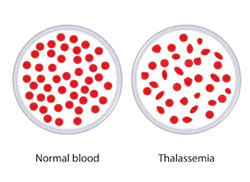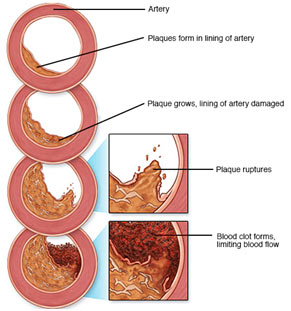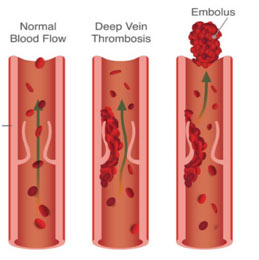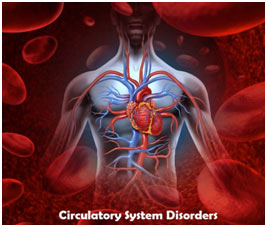There are certain disorders, related to the circulatory system (blood, vessels, heart). Some of them are discussed below:
- 1) 1) Leucaemia (Blood Cancer)
- 2) 2) Thalassaemia (G. Thalassa = The sea; haema = blood)
- 3) 3) Oedema
- 4) 4) Blue babies
- 5) 5) Atherosclerosis (G. athere = porridge; skeleoris = hardening):
- 6) 6) Hypertension
- 7) 7) Cardiac arrest/Heart Attack (Myocardial infarction)
- 8) 8) Stroke
- 9) 9) Haemorrhage
- 10) Multiple Choice Questions (MCQs) with Answers
- 11) Frequently Asked Questions (FAQs) – Disorders of Human Circulatory System
- 12) You may also like to learn:
1) Leucaemia (Blood Cancer)
It is the outcome of unrestrained production of white blood cells (leucocytes). This is brought on by malignant mutation of a myelogenous or lymphogenous cell. Leucaemia is usually characterized by largely increased numbers of unusual white blood cells in the circulating blood.
Myelogenous cells (bone marrow cells) remain in the bone marrow – and might spread out throughout the body, so that white blood cells are produced in many other organs. These white blood cells are not completely differentiated and, therefore are defective.
Leucaemia may be of different types depending upon the kind of leukocyte, which are undifferentiated and being produced at a faster, than normal rate. There might be neutrophilic leucaemia, eosinophilic leucaemia, basophilic leucaemia, monocytic or lymphocytic leucaemia.
Treatment:
It is a very serious condition and the patient needs to alter the blood with the normal blood, got from donors. It can be cured by bone marrow transplant which is in most cases effective, however really expensive treatment.
2) Thalassaemia (G. Thalassa = The sea; haema = blood)
It is also known as Cooley’s anaemia on the name of Thomas B. Cooley, American paediatrician. It is a genetically transferred haemoglobin abnormality. It is defined by the presence of microcytes, by splenomegaly (enhancement of spleen) and by changes in the bones and skin. The blood of these patients is to be replaced frequently, with regular blood.
 Atherosclerosis is a significant condition leading to cardiovascular disease
Atherosclerosis is a significant condition leading to cardiovascular disease
Treatment:
It can be cured by bone marrow transplant – which is very expensive and does not give a 100% treatment rate. Haemoglobin molecule most of the times, does not have (b- chains in it, rather Fchain exists (F is foetal haemoglobin).
3) Oedema
It indicates the existence of excess fluid in the tissues of the body. The excess fluid may be in the cells, or outside the cells. The intracellular oedema is caused by osmosis of water into the cells, and cause depression of metabolic systems (due to lack of nutrition and O2 in the tissues) particularly and the Na-pump.
Extracellular oedema may be the outcome of:
- i) Abnormal leakage of fluid from the blood capillaries or failure of the lymphatic system to return fluid from the interstitial fluid.
- ii) Oedema is triggered by renal retention of salts and water. Oedema interrupts the exchange and concentration of minerals and ions in the blood and body cells, affects blood pressure, increases heart load etc.
4) Blue babies
Failure of the interatrial foramen (an opening in the inter-atrial septum) to close or of ductus arteriosus to fully constrict lead to cyanosis (blueness of skin) of the newborn infant. This is because of the blending of blood between two atria and the combined blood is supplied to the body of newborns resulting in the blueness of the skin, thus the name blue babies.
5) Atherosclerosis (G. athere = porridge; skeleoris = hardening):
It is existing together atheroma and arteriosclerosis; atheroma is the deposition of tough yellow plaque of lipoid product in the innermost layer of the arteries, which might be because of the high level of cholesterol in the blood. Arteriosclerosis is a degenerative arterial change related to advancing age.
Primarily a thickening of the middle layer of arteries, and generally associated with some degree of atheroma. So, Atherosclerosis causes narrowing and hardening of arteries. This increases the danger of formation of thrombus and if the thrombus is formed in the brain or heart it is fatal. Atherosclerosis is a significant condition leading to cardiovascular disease.

6) Hypertension
It is a condition of high blood pressure. Prolonged hypertension damages the lining of the capillary and also causes weakening of heart muscles (which have actually ended up being thickened due to the continuous strain troubled them), with declining efficiency of the pumping action of the heart. Blood might then be retained in the heart and lungs, often leading to a deadly condition called heart disease.
Thrombus Development and Hypertension

Thrombus is a solid mass or plug of blood constituents (clot) in a capillary. This mass may obstruct (wholly or only in part) the vessels in which it forms, or it may be removed and reached some other place in the circulatory system, in which case it is called an embolus. Thrombosis is the formation of thrombus. Thromboembolism is the leading cause of deaths in western civilization.
Thrombus development might be due to the following:
- i) Irritation or infection of the lining of the capillary.
- ii) Reduced rate of blood flow, due to long periods of lack of exercise.
iii) Pneumonia and tuberculosis, emphysema.
7) Cardiac arrest/Heart Attack (Myocardial infarction)
Clot or blockage of a blood vessel in the heart by an embolus (or by locally formed thrombus) triggers necrosis or damage to part of heart muscles, a condition is known as a cardiac arrest or technically myocardial infarction, Cardiovascular disease is due to disruptions of the control system of the heart with accompanying arrhythmias, especially ventricular fibrillation.
We can prevent the above-mentioned situations if we:
- Avoid too much fatty food (especially rich in cholesterol). Keep the normal body weight.
- Control high blood pressure by regular walk and workout.
- Do not smoke.
8) Stroke
If the normal flow of blood is blocked by an embolus (or a locally formed thrombus), in a capillary in the brain, and triggers necrosis, or death, of the surrounding neural tissue (owing to the absence of O2), the condition is called a stroke or cerebral infarction. The symptoms of the stroke differ depending upon the part of the brain that has been damaged.
9) Haemorrhage
It is the discharge of blood from capillary. Particularly essential is the brain haemorrhage which arises from bursting of any of the arteries supplying the brain. When the wall of the arteries becomes hard and loses its flexibility and higher blood pressures would lead to brain haemorrhage. To avoid brain haemorrhage, the high blood pressure must be controlled in between normal limitations.
In almost all the above pointed out problems, it is necessary to take following preventive measures:
- Taking in of less cholesterol in our food. Maintenance of normal blood pressure.
- Do not end up being overweight.
- Do not smoke.
- Do a regular workout.
- Avoid stress and tension.
Multiple Choice Questions (MCQs) with Answers
1. What is the primary cause of Leucaemia (Blood Cancer)?
- a) Uncontrolled production of red blood cells
- b) Malignant mutation of white blood cells
- c) Insufficient production of platelets
- d) Bone marrow deficiency
Answer: b) Malignant mutation of white blood cells
2. What type of cells are defective in Leucaemia?
- a) Red blood cells
- b) Platelets
- c) White blood cells
- d) Neutrophils
Answer: c) White blood cells
3. Which treatment is commonly used for Leucaemia?
- a) Antibiotics
- b) Bone Marrow Transplant
- c) Chemotherapy
- d) Bloodletting
Answer: b) Bone Marrow Transplant
4. What is the primary cause of Thalassaemia (Cooley’s anaemia)?
- a) Genetic mutation of red blood cells
- b) Abnormal production of white blood cells
- c) Lack of platelet formation
- d) Deficiency in hemoglobin chains
Answer: d) Deficiency in hemoglobin chains
5. What is the characteristic feature of Atherosclerosis?
- a) Excess fluid in tissues
- b) Hardening and deposition of plaque in arteries
- c) Genetic transfer of hemoglobin abnormality
- d) Uncontrolled bleeding in capillaries
Answer: b) Hardening and deposition of plaque in arteries
6. What condition is associated with prolonged hypertension?
- a) Oedema
- b) Thrombus development
- c) Cyanosis in newborns
- d) Cardiovascular disease
Answer: d) Cardiovascular disease
7. What is the leading cause of death in Thromboembolism?
- a) Pneumonia and tuberculosis
- b) Irritation or infection of the capillary lining
- c) Reduced rate of blood flow due to lack of exercise
- d) Formation of solid mass or plug in a blood vessel
Answer: d) Formation of solid mass or plug in a blood vessel
8. What is the condition caused by the blockage of a blood vessel in the heart by an embolus or thrombus?
- a) Stroke
- b) Hypertension
- c) Cardiac arrest/Heart Attack
- d) Haemorrhage
Answer: c) Cardiac arrest/Heart Attack
9. What preventive measure is suggested to avoid brain haemorrhage?
- a) Smoking cessation
- b) Regular exercise
- c) Maintaining normal blood pressure
- d) Increased intake of cholesterol-rich food
Answer: c) Maintaining normal blood pressure
10. What is the primary symptom of a Stroke or Cerebral Infarction?
- a) Blue skin discoloration
- b) Necrosis of heart muscles
- c) Cyanosis in newborns
- d) Death of surrounding neural tissue
Answer: d) Death of surrounding neural tissue
11. What is the discharge of blood from capillaries known as?
- a) Atherosclerosis
- b) Haemorrhage
- c) Thrombosis
- d) Oedema
Answer: b) Haemorrhage
12. What condition is caused by the failure of the interatrial foramen to close or ductus arteriosus to fully constrict?
- a) Atherosclerosis
- b) Blue babies
- c) Leucaemia
- d) Oedema
Answer: b) Blue babies
13. What is the primary cause of Intracellular Oedema?
- a) Renal retention of salts
- b) Abnormal leakage from blood capillaries
- c) Failure of the lymphatic system
- d) Osmosis of water into cells
Answer: d) Osmosis of water into cells
14. Which of the following is NOT a preventive measure for circulatory system disorders?
- a) Regular exercise
- b) Smoking
- c) Cholesterol-rich diet
- d) Maintaining normal blood pressure
Answer: c) Cholesterol-rich diet
15. What is the primary cause of Hypertension?
- a) Weakening of heart muscles
- b) Reduced blood flow due to lack of exercise
- c) High blood pressure
- d) Thrombus development
Answer: c) High blood pressure
16. Which disorder is related to the abnormal production of white blood cells?
- a) Atherosclerosis
- b) Leucaemia
- c) Thalassaemia
- d) Oedema
Answer: b) Leucaemia
17. What is the primary cause of Atherosclerosis?
- a) Genetic mutation of red blood cells
- b) Deposition of lipoid plaque in arteries
- c) Failure of lymphatic system
- d) Increased blood flow
Answer: b) Deposition of lipoid plaque in arteries
Frequently Asked Questions (FAQs) – Disorders of Human Circulatory System
1. What is Leucaemia, and what causes its development?
- Leucaemia, or blood cancer, is characterized by the unrestrained production of white blood cells (leucocytes). It results from the malignant mutation of myelogenous or lymphogenous cells, leading to an increased number of defective white blood cells in the circulating blood.
2. What are the different types of Leucaemia based on the kind of leukocyte produced?
- Leucaemia may include neutrophilic leucaemia, eosinophilic leucaemia, basophilic leucaemia, monocytic, or lymphocytic leucaemia.
3. How is Leucaemia treated?
- Treatment for Leucaemia involves altering the blood with normal blood obtained from donors. A bone marrow transplant, though expensive, is often an effective method.
4. What is Thalassaemia, and what are its defining characteristics?
- Thalassaemia, also known as Cooley’s anaemia, is a genetically transferred haemoglobin abnormality. It is characterized by the presence of microcytes, splenomegaly, and changes in bones and skin.
5. What is the recommended treatment for Thalassaemia?
- Thalassaemia can be treated with a bone marrow transplant, although it is an expensive procedure with a less than 100% success rate. Frequently, the haemoglobin molecule lacks β-chains, and fetal haemoglobin (F-chain) is present.
6. What does the term “Oedema” indicate, and what are its causes?
- Oedema indicates the presence of excess fluid in the tissues of the body. It can be intracellular, caused by osmosis of water into cells, or extracellular due to abnormal leakage of fluid from blood capillaries or failure of the lymphatic system.
7. What causes Blue Babies, and what is the resulting condition?
- Blue Babies result from the failure of the interatrial foramen or ductus arteriosus to fully constrict, leading to cyanosis (blueness of the skin) in newborns.
8. How is Atherosclerosis defined, and what are its components?
- Atherosclerosis involves the deposition of a tough yellow plaque of lipoid material (atheroma) in the innermost layer of arteries. It is often associated with arteriosclerosis, a degenerative arterial change related to advancing age.
9. What is the primary cause of Hypertension, and what are its consequences?
- Hypertension is a condition of high blood pressure. Prolonged hypertension damages the lining of capillaries and weakens heart muscles, potentially leading to heart disease.
10. What is the role of Thrombus in the circulatory system, and what causes its formation? – Thrombus is a solid mass or plug of blood constituents (clot) in a capillary. It forms due to irritation or infection of the capillary lining, reduced blood flow, or certain medical conditions like pneumonia and tuberculosis.
11. What is the difference between Cardiac Arrest and Myocardial Infarction? – Cardiac arrest refers to the sudden stoppage of heart function, while myocardial infarction is the necrosis or damage to part of heart muscles due to a clot or blockage in a blood vessel.
12. What is the primary cause of Stroke, and what are its symptoms? – Stroke occurs when the normal flow of blood in a brain capillary is blocked by an embolus or locally formed thrombus, resulting in the necrosis or death of surrounding neural tissue. Symptoms vary based on the affected brain region.
13. Why is it important to control high blood pressure in preventing Haemorrhage? – Haemorrhage is the discharge of blood from capillaries, and brain haemorrhage, in particular, is essential to control by maintaining normal blood pressure. The hardening and loss of flexibility in arterial walls can lead to brain haemorrhage.
14. What preventive measures can individuals take to reduce the risk of circulatory system disorders? – To reduce the risk of circulatory system disorders, individuals should consider the following measures: – Maintain a diet with less cholesterol. – Keep normal body weight. – Avoid smoking. – Engage in regular exercise. – Manage stress and tension.
Summary – Disorders of Human Circulatory System TutorialThe tutorial on Disorders of the Human Circulatory System explores various conditions affecting the blood, vessels, and heart. It delves into specific disorders, their characteristics, and potential treatments. Here’s a brief summary of the key topics covered:
- Leucaemia (Blood Cancer): Resulting from uncontrolled production of defective white blood cells, Leucaemia has various types, such as neutrophilic, eosinophilic, basophilic, monocytic, or lymphocytic. Treatment involves blood alteration with normal blood or bone marrow transplant.
- Thalassaemia: A genetically transferred haemoglobin abnormality, Thalassaemia is characterized by microcytes, splenomegaly, and bone and skin changes. Treatment, often requiring a bone marrow transplant, may not guarantee a 100% success rate.
- Oedema: Excess fluid in body tissues can be intracellular or extracellular, caused by abnormal leakage of fluid, renal retention of salts and water, or lymphatic system failure.
- Blue Babies: Cyanosis in newborns, known as blue babies, results from the failure of specific openings to close, leading to the mixing of blood between two atria.
- Atherosclerosis: Involving the deposition of plaque in arteries, Atherosclerosis causes narrowing and hardening, increasing the risk of fatal thrombus formation. It is a significant contributor to cardiovascular disease.
- Hypertension: Prolonged high blood pressure damages capillary linings and weakens heart muscles, potentially leading to heart disease.
- Thrombus Development: Solid masses or plugs of blood constituents (clot) in capillaries, thrombus development can result from irritation or infection, reduced blood flow, or specific medical conditions.
- Cardiac Arrest/Heart Attack: Blockage of a blood vessel triggers damage to heart muscles, resulting in cardiac arrest or myocardial infarction.
- Stroke: Blockage in brain capillaries leads to the death of surrounding neural tissue, resulting in a stroke or cerebral infarction.
- Haemorrhage: The discharge of blood from capillaries, particularly crucial is brain haemorrhage, which can be caused by the hardening and loss of flexibility in arterial walls due to high blood pressure.
Preventive measures for these disorders include maintaining a diet low in cholesterol, normalizing blood pressure, avoiding smoking, engaging in regular exercise, and managing stress.
This tutorial provides valuable insights into circulatory system disorders, emphasizing the importance of awareness and preventive measures.

